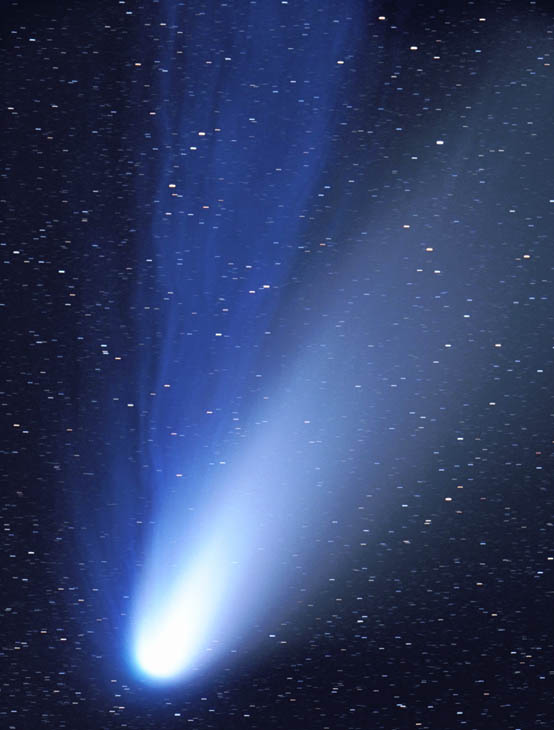
Image courtesy of John Gleason and Celestial Images
 Copyright © Michael Richmond.
This work is licensed under a Creative Commons License.
Copyright © Michael Richmond.
This work is licensed under a Creative Commons License.
Homework, due Thursday, March 24, in class
You all know what comets look like: fuzzy balls of light followed by a long tail:

Image courtesy of John Gleason and Celestial Images
Q: Why does Comet Hale-Bopp show TWO tails,
one blueish and one whitish?
The whitish tail is due to light reflected by dust particles which have been released as the comet's surface vaporizes. The dust particles reflect sunlight of all wavelengths equally well (to a good approximation), so their color is that of the Sun: yellowish-whitish. The blue tail is light reflected by ions which have also been knocked off the comet by sunlight. Ions are simply charged particles, atoms from which at least one electron has been removed or added. The ions are much smaller than the dust particles, much smaller than the wavelength of visible light. As a result, they reflect short blue wavelengths more efficiently than red ones -- in the same way that molecules in Earth's atmosphere reflect blue light better than red light, and so make the sky look blue.The reason the two tails are pointing in slightly different directions is that the charged ions are deflected by the Sun's magnetic field, so they drift away from the comet in a slightly different direction than the neutral dust particles.
They fly past the Earth, becoming brighter and larger as they near the Sun, then fading and shrinking as they leave. So, where do they come from? What's their source? Are they visitors from other stellar systems, or do they belong to our own Solar System?
Over the years, astronomers noticed that one could divide the comets into two groups:
Why are there two groups? Do they have the same source, or are they completely different populations?
In 1950, Dutch astronomer Jan Oort proposed a source for the long-period comets. He suggested that the Solar System was surrounded by a vast, roughly spherical cloud of comets, stretching out towards interstellar space.

Because the the bodies in this Oort cloud, as it came to be known, are so far away from the Sun, the gravitational forces binding them to the Sun must be very weak. These comets would spend hundreds of thousands of years slowly moving along their orbits, always remaining far from the planetary zone. Over millenia, other stars move past our Solar System at great distances; if one should pass within a few light years, its gravitational pull might disrupt the orbit of a comet in this cloud, causing it to fall into the inner Solar System.
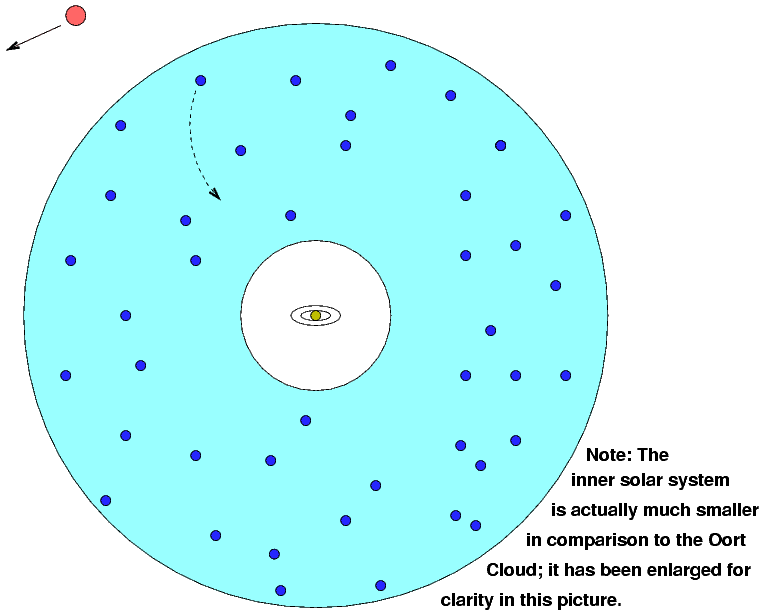
In 1949, K. E. Edgeworth proposed that there might a collection of icy bodies in a region just outside the orbit of Neptune, and that some of these bodies might turn into short-period comets. His paper didn't get much attention. Two years later, Gerald P. Kuiper made a similar suggestion: that early in the history of the solar system, many icy bodies were formed in the outer reaches of the protosolar nebula. Kuiper went on to propose an evolutionary scheme.
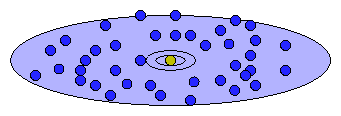
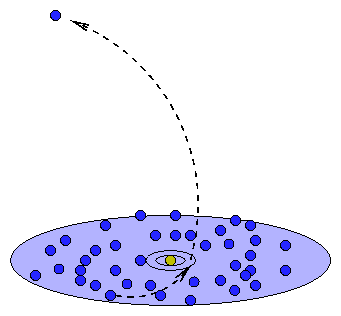
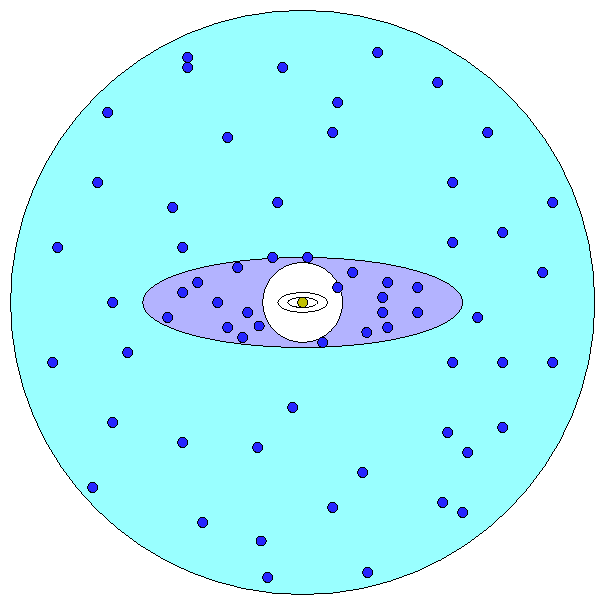
This was an intruiging idea: if we could find objects in this hypothetical belt, we'd be able to sample material from the original protostellar disk. The bodies in this belt would be nearly pristine samples of the material which had formed our Solar System more than four billion years ago.
But --- did they really exist?
In the early nineteen-eighties, a Dutch-English-American satellite called IRAS scanned the entire sky at infrared wavelengths. It detected unusually large amounts of infrared radiation from a number of otherwise ordinary stars. Some astronomers postulated that this infrared excess might be caused by particles of gas and dust orbiting such stars. The particles would absorb some of the star's visible light and re-radiate it at much longer wavelengths. A few stars were close enough that IRAS could actually see a circumstellar disk surrounding the star; the most famous of these was beta Pictoris:
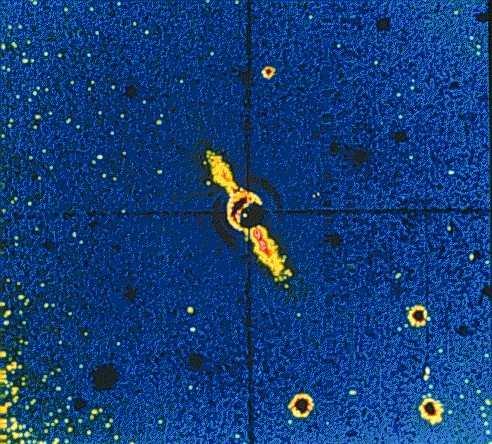
Many other stars were too far away for the little IRAS satellite (its mirror only 24 inches in diameter) to resolve any details of their circumstellar material. Recent observations with bigger telescopes, such as HST in space and the VLT on the ground, provide many more examples of disks around stars. For example, the star HD 141569A has an infrared excess, but only recent images taken by the HRC/ACS coronagraph on HST can show its size and shape. Click on the image to see how the disk compares to the size of our Solar System.
HST has seen disks around other stars, too. As these pictures show, there is plenty of material around some stars at distances slightly larger than the limits of planetary orbits in our own Solar System.
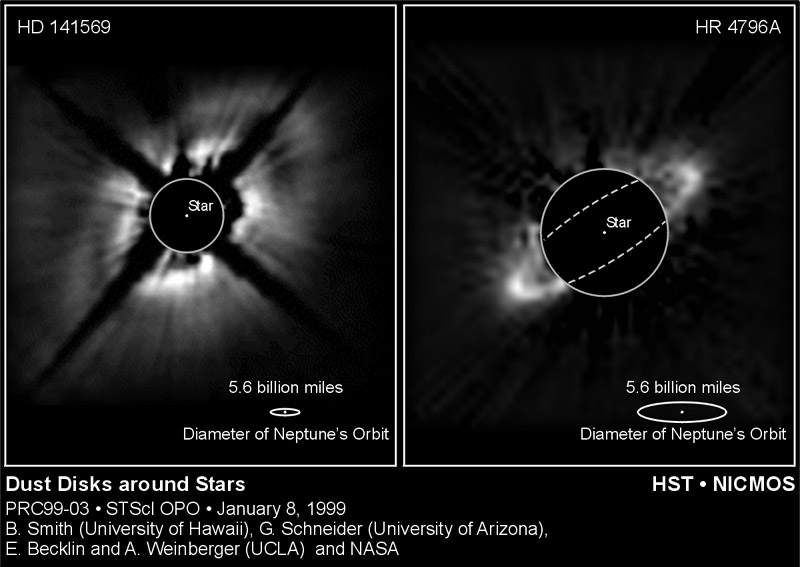
So, is there material in OUR Solar System, somewhere out beyond the orbit of Neptune? That's a hard question to answer, for three reasons:
Q: Neptune is about 30 AU from the Sun.
How much fainter is sunlight falling on Neptune
than sunlight falling on the Earth?
That means that only a small amount of light is available to bounce off any bodies and return to our telescopes.
Clyde Tombaugh, the astronomer who discovered Pluto in 1930, continued his photographic search of the ecliptic for several decades. He found no other bodies beyond Neptune to a limit of about V = 17.5. Charles Kowal spent many years making a deeper photographic survey of selected portions of the sky, down to magnitude V = 20 or so. In 1977, he discovered Chiron, a strange object that refuses to fit neatly into any category. It's big, over 100 km in diameter, but not as big as a planet. Most of the time, it appears as a tiny dot of light, like an asteroid; but every now and then, a coma of material appears around it, like a comet. Its orbit runs from about 8.5 AU -- inside the orbit of Saturn -- to about 19 AU -- just short of the orbit of Uranus; it is therefore a planet-crosser. Gravitational perturbrations by Saturn will knock it out of its current orbit within a few million years. Very strange ... but not quite on topic for today.
Astronomer Dave Jewitt and his graduate student, Jane Luu, started searching for trans-Neptunian objects in the late nineteen-eighties. They used both film (to cover large areas) and a CCD camera (to go deeper over a small area). After five months of hard work in 1987, they ended up with ...
nothing
Did they give up? No, they kept trying. They used the 2.2-meter telescope of the University of Hawaii and a big CCD, which took pictures with a field of view about 7 arcminutes on a side. Their survey covered 1.2 square degrees of sky, equal to an area 66 by 66 arcminutes on a side.
Q: How many of their pictures would it take, placed
side-by-side, to make a thin strip 66 arcminutes long?
Q: How many of their pictures would it take to cover
a square area 66 by 66 arcminutes in size?
Q: If they exposed each image for 15 minutes, how long
would it take to cover their area?
Each image showed hundreds or thousands of stars, the vast majority of which were ordinary stars. How could they hope to find a faint little asteroid among all the stars? It would be like looking for a needle in a haystack ...
Their method was to take several images of the same portion of the sky, between fifteen minutes and an hour apart, and examine all the images simultaneously. Stars would appear in exactly the same place in each image, but any asteroid, comet or other solar-system body would move. Night after night, they stared at their computer screens, flashing back and forth between images, hoping to find a point of light which moved slowly across the screen.
Finally, in 1992, they found it!
Their first discovery, 1992 QB1, was soon followed by other Kuiper Belt Objects, or KBOs for short. Here are some other "movies" compiled from their survey:
Q: If they needed four images at each position to
check for moving objects, how long would it take
to cover their area?
Q: If only half of all nights at the telescope are
clear, and if each night lasts for about six hours,
how many nights of telescope time would it take
to perform this survey?
Q: If they were given two nights per month on the telescope,
how many months would it take to perform this survey?
Other astronomers started finding KBOs, too. On, April 14, 2003, there were 664 KBOs with decent orbits; today, March 22, 2005, there are now 847 known KBOs with good orbits.
Is this all, or just the tip of the iceberg? Take a look at this plot of the locations of those objects:
Q: What causes the clumps in the distribution of KBOs?
Remember that we can only detect the very largest of the KBOs, those at least 50 km in diameter. The number of asteroids rises very sharply as one includes smaller and smaller bodies. Estimates of the total number of objects in the Kuiper Belt range into the billions. However, the total mass of all these bodies is probably less than that of the Earth (but still much more than the total mass of the main belt asteroids).
Just what are these distant members of the Solar System? Asteroids, or comets, or what? Some of them have surfaces which are very red; it's likely that this color is due to icy compounds which have been exposed to cosmic radiation for billions of years. Spectra of some KBOs show absorption features which may be due to water ice. Our best guess is that these objects are largely composed of frozen water, methane, carbon dioxide, ammonia, and other volatile compounds. Right now, in their orbits beyond Neptune, they look like solid chunks of material, reflecting only the sunlight which strikes their surfaces; in other words, they look like asteroids.

No, these aren't KBOs; they are just main-belt
asteroids which have been visited by spacecraft.
But what would happen if one of these frozen blocks should be nudged out of its current orbit and perturbed into the inner reaches of the Solar System, as close as Jupiter? Its outer layers would heat up in the (relatively) intense sunlight to temperatures at which molecules such as water and carbon dioxide sublimate -- turn from solid into gas.

This is a picture of the nucleus of Comet Halley
taken by the Giotto probe
As the outer layers evaporate, they would release any chunks of rocky or metallic material. A shroud of gas and dust would envelope the object, hiding it from direct view while simultaneously spreading outwards into a giant glowing ball. In short, we would call it a comet.

Copyright Gerald Rhemann
And that's where comets come from.
 Copyright © Michael Richmond.
This work is licensed under a Creative Commons License.
Copyright © Michael Richmond.
This work is licensed under a Creative Commons License.